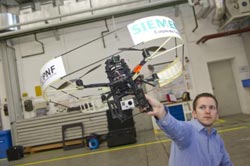Minihelicopter Flies Autonomously

Known as the quadrocopter, the aircraft uses the data to create a 3D digital model of its immediate surroundings.
As reported in Pictures of the Future magazine, computer scientists working for Corporate Technology in Princeton and Munich have teamed up with robotics experts from the Massachusetts Institute of Technology near Boston to develop this sophisticated eye in the sky.
The aim of the project is to create a system capable of producing digital models of complex interiors and inspecting inaccessible installations.
For researchers working in artificial intelligence, the development of a system with visual competence remains, even after 50 years, a major challenge. When it comes to looking at the real world, computers are still remarkably primitive. Whereas a young child has no problem distinguishing a tree from an antenna, computers are incapable of reliably matching such images to the relevant object. Research groups from both science and industry are therefore working hard to enhance the visual capability of artificial systems.
At Siemens, researchers are progressively teaching the quadrocopter how to see. The unmanned system measures almost one meter in diameter and is equipped with four rotors. When in flight, it uses lasers to scan its surroundings. Optical sensors and video cameras record every detail.
In a process known as “supervised learning,” such systems are initially primed with hundreds of thousands of images, thereby imitating the process whereby a child learns to distinguish, say, a tree from an antenna mast on the basis of having already seen a countless number of objects. Intelligent algorithms then search these images for characteristic features. On this basis, the quadrocopter is able to compile a precise 3D digital model of its surroundings in areas such as baggage-handling facilities, factory buildings, or event venues for the purposes of construction planning or building inspection. In the future the aircraft can fly routine operations to inspect largely inaccessible installations such as wind power plants and electricity pylons.
In other projects at a number of its research and development facilities, Siemens is also developing systems that are able to scan aireal images for complex patterns such as industrial sites, buildings, or roads; examine X-ray images of baggage and shipping containers for suspicious objects; identify and read road signs; and monitor crowds.
Media Contact
More Information:
http://www.siemens.com/innovationnewsAll latest news from the category: Interdisciplinary Research
News and developments from the field of interdisciplinary research.
Among other topics, you can find stimulating reports and articles related to microsystems, emotions research, futures research and stratospheric research.
Newest articles

Bringing bio-inspired robots to life
Nebraska researcher Eric Markvicka gets NSF CAREER Award to pursue manufacture of novel materials for soft robotics and stretchable electronics. Engineers are increasingly eager to develop robots that mimic the…

Bella moths use poison to attract mates
Scientists are closer to finding out how. Pyrrolizidine alkaloids are as bitter and toxic as they are hard to pronounce. They’re produced by several different types of plants and are…

AI tool creates ‘synthetic’ images of cells
…for enhanced microscopy analysis. Observing individual cells through microscopes can reveal a range of important cell biological phenomena that frequently play a role in human diseases, but the process of…





















